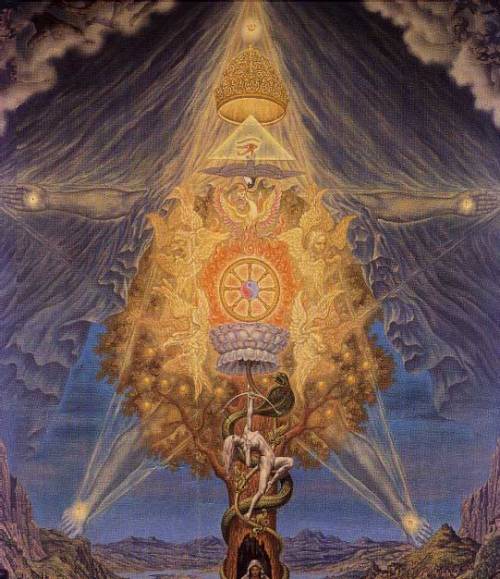thelightofthecenter: The Mystical UnionWere we to meditate upon this composition, our task would be
thelightofthecenter: The Mystical UnionWere we to meditate upon this composition, our task would be to enter through its various symbols to their transcendent Oneness. This meditation would begin with the image as a whole, seeking to find the unity within the totality. Concentrating on the outermost circle, we behold the five-pointed star with the figure of a man inscribed within it. For the Pythagoreans of ancient Greece, the pentagram was symbolic, both mathematically and metaphysically, of absolute perfection To inscribe a human figure in the pentragram is to suggest that the Divine may be manifest in human form, be it as Adam Kadmon of the Cabbalist tradition, or as the Anthropos in of the Gnostic and Hermetic.Here, he appears to be a mystical rendering of Christ, the God-in-man, since he bears glowing wounds in his hands and feet, each inscribed with a Hebrew letter that ultimately spells out YHWH (the Hebrew name of the god ‘Yahweh’ or ‘Jehovah’). At the head of this figure is the Hebrew letter shin, just above the crown. The Cabbalist tradition would again suggest that this figure is the quintessence, the highest unity of water, earth, air and fire. His supremecy and lordship is manifest in the symbol of the crown.Moving inward in our meditations to the next co-centric circle of imagery, we behold the tree laden with twelve fruits. In many traditions, this is the World Tree, symbolic of the cosmos as a whole: its roots thriving in the underworld, its trunk the pillar and axis of our world, and its branches forming the latticework of heaven. The twelve fruits remind us of the final words from the Book of the Apocalypse. Within the walls of the New Jerusalem there will grow “the tree of life with its twelve kinds of fruit, yielding its fruit each month.” (Revelation 22:2) Hence, the tree is not only a symbol of the world, but the cosmos with its twelve astrological signs.We also have a dragon at the base of the tree, and a veiled woman holding a cup. Now we are reminded of the World Ash of Norse mythology, the cosmic tree Yggdrasil, and its dragon Nidhoggr at the root. The veiled woman with the cup re-appears numerous times in Johfra’s works. In The Vision of Hermes Trismegistos, she appears as Nature. Later she will appear as The Primordial Mother. She may also be, according to Norse mythology, one of the three Wyrd women or Norns who “dwell by Urth’s well from which they water the roots of the World Ash” (Joseph Campbell, Creative Mythology, ch III, section III). Johfra Bosschart, Unio Mystica (1973)Source -- source link

